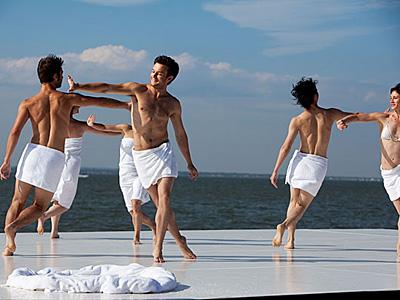The recent Labor Day holiday has heralded the unofficial end of summer. Kids have reluctantly traded beach balls for backpacks; and men (big kids) have cleaned the outdoor grills putting them away in anticipation of the unofficial start of the next summer season, Memorial Day 2014.
For those diehards who are still basking in the season’s afterglow I would like to share with you a noteworthy dance event, the Fire Island Dance Festival 19.
The summer dance event has become a major fundraising component forDancers Responding To AIDS, a program of Broadway Cares, which supports more than 450 AIDS and family service organizations nationwide; as well as the essential programs of The Actors Fund, including the HIV/AIDS Initiative andThe Dancers’ Resource. The three-day festival was held Friday, July 19 thru Sunday, July 21, and this year it raised a record $393,647. Over the past nineteen years the total amount of money raised through these performances exceeds three million dollars.
For the ninth consecutive year the Festival has been presented at the landmark bayside home of Jon Biondo, Tim Horrman and Ryan Coutu. A small-whitewashed entranceway opened onto a tranquil Zen-like water garden complete with a gurgling fountain. The winding wooden walkway leads us to an expansive terraced piazza complete with an Aegean backdrop of water, sky, and sun.
Eleven works (including four premieres) by emerging, established, local and international choreographers and dance companies were presented in a fast paced ninety-minute concert. Mo Rocca returned for the second year as host. His special blend of wit and humor guided the audience through an eclectic mix of terpsichorean delights. Despite a pair of crutches and a bandaged leg due to a torn ligament Rocca remained the consummate showman.
The Broadway Dance Lab opened the performance with an all male sextet In Defense. The choreography was inspired by the 2010 Don’t Ask Don’t Tell Repeal Act, which ended discrimination based on sexual orientation in the armed forces. Through the use of good spatial design and dance driven theatricality choreographer Josh Prince combined just enough implied machismo peppered with an equal amount of camp to remain entertaining while commemorating this auspicious milestone.
Dancers in camouflage army fatigues performed in tight almost militarized unison that shifted into tongue-in-cheek ballroom style partnered dancing. In Defense ended with the three couples exchanging dog tags and embracing. The symbolism was not only empowering, but also presented a window into the future of the military.
The wispy quality of Christopher Wheeldon’s A Place For Us complemented the ethereal music score of Leonard Bernstein and Andre’ Previn. Robert Fairchild and Tiler Peck performed the pas de deux that encompassed choreographer Wheeldon’s trademark partnering and effortless lifts. The choreographer used strong counterpoint elements in the middle section, which was more apparent in Fairchild’s choreography. In the last section Wheeldon and the composers returned to their origin themes to bring the work to a satisfying culmination.
Alvin Ailey American Dance Theater dancers and real life husband and husband Kirven James Boyd and Antonio Douthit masterfully illuminated Robert Battle’s Strange Humors. The visceral duet was set to the driving score of John Mackey. Battle’s choreography ran the gamut of movement imagery, from percussive and primitive to technically dazzling, beautiful and symmetrical to grotesquely angular, it was conversational and confrontational; the sinuous movement quality and compositional unpredictability enthralled the audience.
Only The Beginning by choreographer Jeremy McQueen, featured dancers from the Alvin Ailey American Dance Theater, Dance Theatre of Harlem, Ballet Hispanico and Keigen + Company. The eight-member ensemble work opened with a linear tableau set center stage with a cloaked Daniel Harder upstage. The ensuing high-energy dance was a stylistic blend of jazz, modern, ballet and emerging McQueen, but the centerpiece of the work was a choreographed altercation between Daniel Harder and Christopher Vo. The physically diminutive Harder has an innate ability to command the stage as he dances with his inner giant.
Clifton Brown and Attila Joey Csiki’s eloquent interpretation of Lar Lubovitch’sConcerto Six Twenty-two set to Wolfgang Amadeus Mozart’s Concerto for Clarinet and Orchestra, K622 was a clear and unfettered poetic statement. The work expressed the sophisticated nurturing of an intimate relationship delicately balanced against the reflective emptiness of love lost. The choreography, which incorporated supportive partnering and an organic plastique, created haunting and unforgettable imagery.
Lubovitch’s work premiered nineteen years ago at the first Fire Island performance offered by Dancers Responding to AIDS, and its power still resonates today. Concerto Six Twenty-two ended with the dancers walking upstage with their backs to the audience; then parting one dancer exiting stage left, the other exiting stage right. This left a void onstage; that in many ways was symbolic of the one medical science has yet to fill. The understated beauty of the duet exemplifies one of my favorite quotes by Leonardo Da Vinci, “Simplicity is the ultimate elegance”.
Richard Siegal’s quirky, fun modern dance work trio for Body Traffic was entitled o2Joy. It opened with a solo playfully performed by Tina Finkelman Berkett; who successfully interrupted the scatting vocals and jazz sounds of the Oscar Petterson Trio with assuredness and often-humorous movement. A trio featuring Finkleman, Miguel Perez and Guzman Rosado cleverly punctuated jazz legend Billie Holiday’s richly syncopated rendition of Sunnyside of the Street in the second section. In both sections Finkelman danced with great aplomb.
There was a sparse lyricism in Swedish born choreographer Pontus Lidberg’sDances Written On Water 1. The abstract quartet featured Giovanni Buccheri, Adrian Danchig-Waring, Gabrielle Lamb, and choreographer Lidberg and utilized a series of circular patterns that seemed to engulfed the stage. The cerebral work gave a different perspective to Rachmanov’s lush and often dramatically ascribed Etudes-Tablaeux for piano.
The number providing the greatest levity was a rendition of Turkey Lurkey Time from the musical Promises, Promises. Antoine Ramone and Christopher Vo were backup dancers for Mo Rocca who shuffled, limped, and arm danced substituting high kicks with grand battlement à la crutches. This self-effacing jazz number received a well-deserved standing ovation.
In past Fire Island Dance Festival performances Kyle Abraham/Abraham.In.Motion has distinguished itself with edgy social commentary works. Kaleidoscope Pines, was a pure movement work that revealed the choreographer’s range as a versatile dance maker. Modern, contemporary, and street dance elements were combined in this ensemble work with great success.
Arms in fifth position moving overhead in a circular pattern; and open, unencumbered upper body movement were combined with stag jumps, abandoned swirling arabesques turns and “club culture” vogue arms with parallel plie’ walking steps. These movements have become synonymous with Abraham’s manifesting style. The work designed for three women and five men and set to the up tempo music of yMusic; displayed a strong sense of musicality with solid choreographic structure
Leave it to Paul Taylor to remind us of the best from the Age of Aquarius. The solo from A Field Of Green opened with dancer Robert Klienendorst sitting on stage smoking what looked like a marijuana cigarette. A large portion of audience immediately broke out in vicarious laughter, and it wasn’t long before we all experienced a “contact high”. This concise work, in the hands of master dance maker Taylor was an example of how less can be more.
Evidence, A Dance Company closed the program with an excerpt from Torch, which honored the life and memory of dancer Beth Young. Brown has developed an indelible signature style, which extends beyond physical dancing; it also encompasses his choreographic structure. Brown’s prowess also allowed him to meld dancers of varied technically levels, and traditional with non-traditional body types to his advantage. The infectious driving mixed music score by Busiswa Gqulu coupled with West African infused modern dance movement phases had the audience dancing in their seats.
The Fire Island Dance Festival 19 again demonstrated how the arts and a community could come together to make a difference in lives of individuals affected by what continues to be the scourge of the 21st century. For more information about Dancers Responding To AIDS, the related services and year-round programming, or to make a donation visit the websitewww.dradance.org.
In Photo: 1) Robert Fairchild and Tiler Peck 2) Kirven James Boyd and Antonio Douthit 3) Attila Joey Csiki and Clifton Brown 4) Miguel Perez and Guzman Rosado 5) Brittanie Brown and Chalvar Monteiro 6) Robert Klienendorst.
Become a Harlem Insider!
By submitting this form, you are consenting to receive marketing emails from: Harlem World Magazine, 2521 1/2 west 42nd street, Los Angeles, CA, 90008, https://www.harlemworldmagazine.com. You can revoke your consent to receive emails at any time by using the SafeUnsubscribe® link, found at the bottom of every email. Emails are serviced by Constant Contact









